Roman villas and mosaics
After the Greeks, the Romans left an equally rich legacy in Sicily — one preserved not in temples but in luxurious villas adorned with intricate mosaics. These masterpieces reveal the refinement, mythological imagination, and daily life of ancient Roman Sicily.
- Visit Sicily
- 3 min read

Roman Villas and Mosaics in Sicily — Art and Life of an Empire
🧭 Overview
During the Roman Empire, Sicily was known as the granary of Rome, supplying wheat and olive oil to the capital. Wealthy landowners built grand villas across the island, showcasing both prosperity and taste. Their mosaics — vibrant, detailed, and remarkably preserved — stand among the most important in the ancient world.
🏛️ 1. Villa Romana del Casale (Piazza Armerina)
- Location: Central Sicily, near Enna.
- Significance: A UNESCO World Heritage Site and one of the most spectacular Roman villas anywhere.
- Highlights:
- Over 3,500 m² of mosaics, the largest and best-preserved collection in the Roman world.
- “Bikini Girls” mosaic — depicting women exercising, unique for its athletic theme.
- Hunting scenes with exotic animals and mythological depictions such as Hercules and Orpheus.
- Complex layout with baths, courtyards, and guest rooms.
- Tip: Visit early morning or late afternoon for softer light and fewer crowds.
🏺 2. Roman Theatre of Taormina
- Location: Taormina, on Sicily’s east coast.
- Originally Greek, it was later expanded by the Romans for gladiatorial games.
- Features: Stone seating, grand arches, and panoramic views of Mount Etna and the Ionian Sea.
- Though not a villa, it reflects the Roman adaptation of Greek spaces for entertainment and civic pride.
🏛️ 3. Terme Romane (Roman Baths) in Syracuse and Palermo
- Syracuse: Beneath Piazza Duomo, remains of Roman baths show how urban Sicilians lived and socialized.
- Palermo: Fragments of baths and floor mosaics are preserved in the Archaeological Museum.
- Both illustrate the Roman love of public bathing and architectural engineering.
🧱 4. Marsala and Mozia — Western Roman Traces
- Near Marsala, ruins of villas and mosaics have been uncovered on Mozia Island, once a Phoenician settlement later inhabited by Romans.
- Artifacts include amphorae, coins, and fresco fragments.
- The region’s olive oil and wine production date back to this period — a tradition still alive today.
🏞️ 5. Roman Villas in Sicily’s Countryside
Lesser-known sites complement the grandeur of Piazza Armerina:
- San Biagio (Palermo province): mosaics with geometric and floral motifs.
- Tellaro Villa (near Noto): 4th-century mosaics showing hunting and banquet scenes, restored in situ.
- Contrada Durrueli (Agrigento): remains of rural Roman houses integrated into ancient Akragas.
Tip: These smaller sites offer quieter visits and glimpses into provincial Roman life.
🎨 6. Symbolism and Craftsmanship of Sicilian Mosaics
- Materials: Tiny tesserae of marble, glass, and colored stones.
- Themes:
- Mythological heroes (Hercules, Orpheus, Dionysus).
- Nature and hunting — symbols of abundance.
- Daily life — athletes, musicians, and servants.
- Style: Influenced by North African and Eastern Mediterranean schools of mosaic art.
- The mosaics’ narrative richness bridges Roman opulence and local Sicilian identity.
🏺 7. Museums Preserving Roman Artifacts
- Archaeological Museum of Syracuse (Paolo Orsi): Roman sculpture, inscriptions, and mosaics.
- Regional Archaeological Museum Palermo: fragments from villas across western Sicily.
- Agrigento Museum: Roman pottery and coins from Akragas.
💡 Visiting Tips
- Combine Villa Romana del Casale with Enna’s medieval castle for a full-day trip.
- Allow 2–3 hours to explore the mosaics in detail.
- Bring non-slip shoes — walkways can be uneven.
- Guided tours or audio guides help interpret the mythological stories.
🌅 Summary
The Roman villas and mosaics of Sicily reveal an island at the crossroads of empire and art. From the shimmering Villa Romana del Casale to the rural estates of Noto and Agrigento, these masterpieces offer a vivid glimpse into ancient luxury, craftsmanship, and imagination — proof that Sicily was as refined as it was vital to Rome’s prosperity.